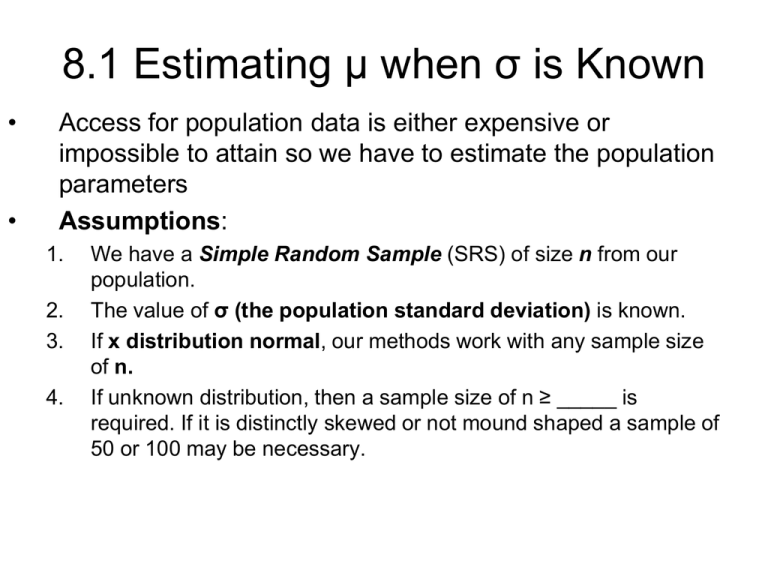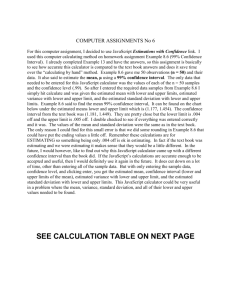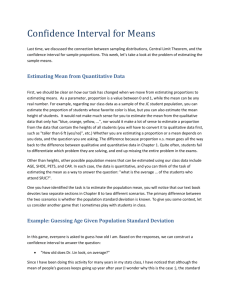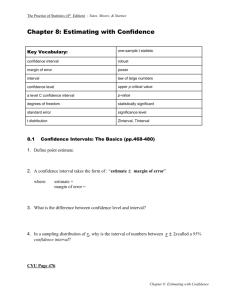
8.1 Estimating μ when σ is Known
•
•
Access for population data is either expensive or
impossible to attain so we have to estimate the population
parameters
Assumptions:
1.
2.
3.
4.
We have a Simple Random Sample (SRS) of size n from our
population.
The value of σ (the population standard deviation) is known.
If x distribution normal, our methods work with any sample size
of n.
If unknown distribution, then a sample size of n ≥ _____ is
required. If it is distinctly skewed or not mound shaped a sample of
50 or 100 may be necessary.
8.1 Estimating μ when σ is Known
• Point estimate of a population parameter is an
estimate of the parameter using a single
number.
_____ is the point estimate for μ
When using x as a point estimate for μ, the
margin of error is | x - μ |
Also, we cannot be certain that our point
estimate is correct but we can have a certain
percent of confidence that it is correct.
8.1 Estimating μ when σ is Known
• For Confidence level c, the critical value
zc is the number such that the area under
the standard normal curve is between –zc
and zc ,equals c.
• Find 99% confidence z value.
• Find 95% confidence z value
8.1 Estimating μ when σ is Known
• Interpretation of confidence interval
“We are 95% confident that mean math SAT score of all
high school seniors is between 452 and 470”
• Confidence level c
– Gives probability that the interval will capture the true
parameter value in repeated samples
• Interpretation: “95% of all possible random samples of
size 500 will result in a confidence interval that includes
the true mean math SAT score of all high school seniors”
8.1 Estimating μ when σ is Known
• margin of error is | x - μ | = zc σ = E
n
So x- E μ x + E or
x – zc σ μ x + zc σ
n
n
8.1
Example 1:
A jogger jogs 2 miles/day
Time is recorded for 90 days
σ = 1.8 min, x =15.6 min
Find a 95% confidence interval for μ , the
average time required for a 2-mile jog
over the past year.
8.1 Estimating μ when σ is Known
•
To find confidence interval
1. Find Error E = zc σ / n
2. Subtract from x on low side and add to x on
high side.
3. Write range.
• Example 2:
• A sociologist is studying the length of
courtship before marriage in a rural district
of Kyoto, Japan. A random sample of 56
middle-income families was interviewed. It
was found that the average length of
courtship was 3.4 years. If the population
standard deviation was 1.2 years, find an
85% confidence interval for the length of
courtship for the population of all middleincome families in this district.
8.1 Estimating μ when σ is Known
• Sample size for estimating the mean .
Sometimes we want an know how many
samples need to be taken to limit the error.
n = zc σ 2
E
• Example 3
• Light fixtures Assembly
• Suppose we need the mean time μ to
assemble a switch.
• In 45 observations, s = 78 seconds.
• Find the number of additional observations
needed to be 95% sure that xbar and mu
will differ by no more than 15 seconds.
8.2 Inference for mean when unknown
• Use t-distribution with s (standard deviation of sample) as
point estimate for .
• Standard error:
SEx = s/ n
s = std dev. of sample
n = number of trials
d.f. = n - 1 (degrees of freedom)
• t-distribution:
– similar in shape to normal distribution
– spread is greater (height lower in the middle; more
probability in tails)
– As d.f (degrees of freedom) increases (n-1)
• t- distribution becomes more normal
• Also s approaches as n increases
8.2 Estimating µ when σ is unknown
Finding t confidence level
• Find tc for 0.95 confidence level when the
sample size is 17.
• Find tc for 0.75 confidence level when the
sample size is 15.
• Find tc for .75 confidence level when the
sample size is 2
• Find tc for 0.99 confidence level when the
sample size is 300.
8.2 Inference for mean when unknown
•
•
•
•
•
Margin of Error = t* s/ n
t-confidence interval
x bar – t* s/ sqrt (n) x bar+ t* s/sqrt(n)
t – value for t(n-1) for specified confidence
level c
Conditions:
1. SRS
2. Normal population or close
(Look for extreme skewness or outliers, or bimodel)
8.2 Inference for mean when unknown
• T procedures can be used if:
n 40 except with large outlier in data
n 15 okay except for strong skewness or
outliers
N 15 data needs to be close to normal
8.2 Example 1
• Suppose an archaeologist discovers only seven
fossil skeletons from a previously unknown
species of miniature horse. The shoulder heights
(cm) are
• 45.3 47.1 44.2 46.8 46.5 45.5 47.6
• Find xbar and s, Assume population is
approximately normal.
• Find the degrees of freedom
• Find tc for a confidence level of .99
• Find E (error)
• Find the confidence interval
• State the confidence level related to this problem.
8.2 Example 2
• A company has a new process for
manufacturing large artificial sapphires. In a
trial run, 37 sapphires are produced. The mean
weight for these 37 gems is
• xbar = 6.75carats, and the sample standard
deviation is s = .33 carat.
• Find the degrees of freedom
• Find tc for a confidence level of .95
• Find E (error)
• Find the confidence interval
• State the confidence level related to this
problem.












